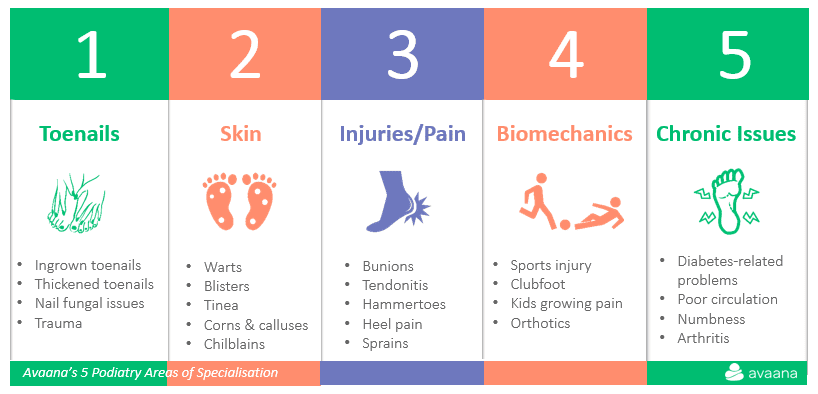When was the last time you took a close look at your feet to assess what condition they are in? If you’re like the rest of Australia (and most of the world!), it’s probably been a really long time. We tend to visit dentists, doctors and optometrists more frequently than a podiatrist, if at all.
In 2018, the Australia Podiatry Association conducted a survey with Scholl Australia, and found that that 78% of people don’t prioritise their foot health.
You know it’s true – these little piggies always come last!

Why it’s important to look after your feet
By monitoring the health of your feet, nails, and toes, you’re reducing the chances of bone and joint problems later in life. You’ll also notice any imbalances in posture or gait that you can fix now, before they lead to hip pain, knee pain, or back pain. Regular nail care will ensure there are no fungal infections, injuries, or underlying health conditions going unnoticed.
When to visit your podiatrist
The table below shows the 5 areas in which podiatrists can provide professional advice and treatment. A podiatrist will check your feet, treat any issues that need may also give us at-home strategies that help prevent and improve any ongoing issues.

Dealing with ingrown toenails
One of the most common reasons for a person to visit a podiatrist is ingrown toenails. This can be very painful, and when left untreated, can get in the way of your daily life. An ingrown toenail is when the edges of the toenail begin to curve and grow into the flesh of the toe. This could happen because of tight shoes or if you cut your nails in the wrong way, or in some cases, it could be just the way your toenail grows.
How to treat ingrown toenails at home
If you suffer from frequent or chronic ingrown toenails, you should know some how to treat mild cases at home:
Soak your feet in warm water a few times a day to soften the nail. Once your nails are softened, use a cotton swab soaked in antiseptic cream to push the nail away from the flesh and back into place. Apply an antiseptic cream to the area to prevent bacteria from settling in.
Avoid wearing tight shoes or boots that press on your toenails. If the discomfort doesn’t go away in a few days, if the toenail is infected, or if you have health complications like diabetes or poor circulation, you should see an expert.
Podiatrist ingrown toenail procedure: What you need to know about ingrown toenail surgery
When you visit a podiatrist for ingrown toenail surgery, you’ll undergo a minor outpatient procedure.
Do ensure you remove any nail polish and wear open toe sandals when you go in. Avoid using any moisturiser, foot deodorant or any other chemicals on your feet.
The procedure begins with cleaning the toes and feet. A local anaesthesia will be administered, and you’ll be prepped or positioned for surgery.
Depending on the severity of your ingrown toenail, the podiatrist may need to remove only a part of the nail or the entire nail. If the entire nail is removed (you won’t feel it!), it may not grow back, and if it does, it will look different from your old nail.
The podiatrist will end by covering your toe with a sterile bandage. You can go home after that, but you will not be able to drive, and it is recommended that you keep your feet up for a couple of days after the operation. You’ll be provided with antibiotics and painkillers, as well as any instructions to care for your toes.
Podiatrist ingrown toenail recommendations: How to avoid getting ingrown toenails
- Avoid wearing shoes that are very tight or that press your toes together.
- When you cut your nails, cut them straight across and not too short.
- When working with heavy objects, wear protective shoes to keep your toes safe.
- Choose your pedicurist carefully – an unskilled aesthetician can do more damage to your toenails than good.
- If you participate in any activity that involves high impact blows to your feet, like football (or ballroom dancing!), make sure you go barefoot at home for some time afterwards.
It’s recommended that we see a podiatrist annually and more if you have high risk conditions like hypertension, diabetes, cancer, obesity or lower limb arthritis.
You should also see a podiatrist if you notice any changes in your feet, ankles or lower limbs. Some examples include:
- Foot odour
- Ingrown or discoloured toenails
- Injury or pain
- Calluses, corns or skin rashes
- Ulcers or foot bumps and lumps
- Redness, swelling or colour change
If you’re in need of some foot TLC, Avaana can connect you with the right podiatrist for you. During your appointment, a podiatrist will examine your foot and use specific tools and devices to help treat and diagnose any foot and lower limb conditions. Most podiatry consultations will take place at a private practice with home visits available for the elderly in nursing homes.



